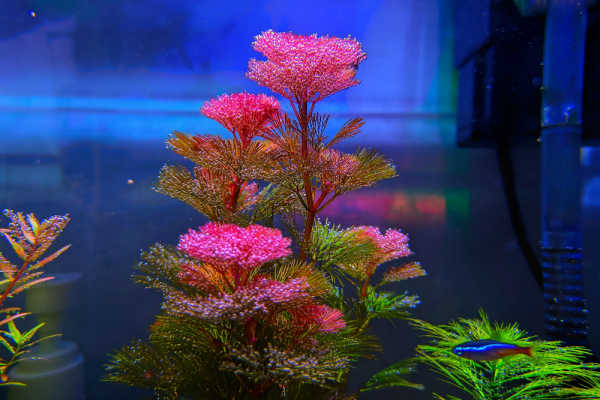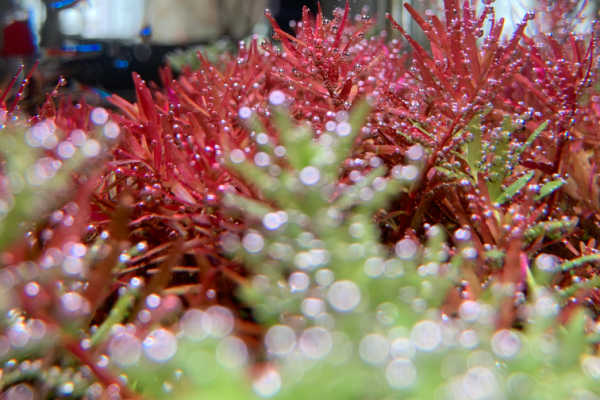11 Things to Know Before Buying Aquatic Plants
Posted by on 06/16/2023
Whether you own a freshwater aquarium or a high-tech CO2-injected planted tank, expanding your collection of plants is one of the most exciting parts of aquarium keeping. If you're looking to purchase plants, either in-purchase or online, there are a few things you should know before making a purchase. In this post, we'll outline 11 things to look out for before buying aquatic plants.
January's Giveaways on Light Fish
Our Top 11 Things to Know
Let's face it, aquarium plants are downright awesome. But purchasing an aquarium plant isn't as straightforward as one might think.
Here's our list of 11 things to know before moving forward with a purchase.
CO2
Some of the brightest aquarium plants in the hobby are often the most sought-after. Hemianthus Callitrichoides (also known as Dwarf Baby Tears), Cryptocoryne sp. 'Pink Panther', and Alternanthera Reineckii are just a few of many favorites among hobbyists. However, those new to purchasing plants may be surprised to know that these plants greatly benefit from added CO2.
CO2 is typically injected into an aquarium through a diffuser, but hobbyists looking to save some money on a CO2 setup can explore DIY options.
CO2 is typically the biggest barrier to entry for hobbyists looking to purchase more difficult-to-care-for aquatic plants.
Lighting
It's no surprise that plants need light to grow, and hobbyists should be well aware of a plant's lighting requirement before making a purchase.
Certain plants require high light to thrive, and you'll need to know the strength of your light fixture before purchasing certain types of aquatic plants.
Luckily, there's a way to measure light intensity in an aquarium. A par meter can be used to measure the brightness of light along the substrate. Although expensive to purchase, you may be able to rent one to save some extra cash.
Water Chemistry
Since aquarium plants are sourced from different parts of the world, many plants require specific water chemistry to thrive.
The majority of the plants found in the hobby come from warm, tropical environments, where water tends to be acidic or pH-neutral. This presents a challenge for those of us that live in cities, where tap water tends to be much harder than those living in the countryside, where water sources tend to be more pH-neutral.
Luckily, you can lower your water hardness by injecting CO2, but hobbyists can also make their water more acidic by purchasing an RO/DI unit. The process of making RO/DI water can easily take a few hours, and to shortcut the process, many consider purchasing RO/DI water instead.
Growth Rate
Given the right conditions, aquarium plants can grow quite fast. Some stem plants can easily grow a few inches over a 7-day period, which means more frequent trimmings and maintenance for hobbyists.
However, other plants, such as species of Anubias, are slow growers. You'll want to factor in a plant's growth rate so that you can decide how much time you plan on dedicating to your planted aquarium.
Propagation
One of the best parts about owning aquarium plants is propagating them. After your plants are well-established in your aquarium, you'll easily be able to propagate them by trimming frequently.
Certain plants should be trimmed in different ways. Stem plants can be chopped right at the stems, with some hobbyists preferring to leave the bottoms of the stem in place, and replanting the cut portion. On the other hand, Rhizome-based plants, such as Java Fern, need to be trimmed along the root crown. Determining how to properly propagate your plants will allow you to create lush carpets, and thick shrub-like backgrounds in your tank. Best of all, you can easily sell them to other hobbyists on our marketplace.

Water Flow
You'll want to have a good amount of flow throughout your tank so that plants can absorb CO2 and nutrients directly from the water column. However, some plants prefer to stay out of direct flow, or can easily get knocked over.
If your aquarium has a lot of existing flow, you'll need to be mindful of the circulation pattern in your tank, so that you can position and adjust your plants accordingly.
Alum Dip
Bladder snails are an invasive species that can easily overtake a tank. While they do provide a few benefits to an aquarium's ecosystem, most hobbyists view them as pests and want to quickly remove them from their tanks.
Many aquatic plant sellers will "alum dip" their plants. Alum, an abbreviation for aluminum potassium sulfate and water, is a mixture that will quickly kill off any pest snails, worms, or invasive insects.
While plant sellers will try their best to remove these snails, it's not uncommon for a few species to find their way into an aquarium. Luckily, assassin snails can be purchased to hunt down these aquatic pests.
Temperature
The majority of aquatic plants will prefer a warm-water environment, making an aquarium heater a must for most hobbyists. However, there are a few plants that can thrive in cold water and room temperature conditions.
Java moss, Java Fern, Duckweed, Anubias Nana, and Limnophila aquatica are a few plants that can thrive in an aquarium without a dedicated heater. However, plants will grow at a much slower rate in a cold water environment.
Substrate
Hobbyists will want to ensure any potential plant purchase can thrive in their current aquarium's substrate. Play sand-based substrates may hinder the growth of certain plants, and gravel-based substrates may also make initial planting difficult depending on the granule size.
Luckily, some of the most popular aquarium substrates, such as Eco-complete and Fluval's Stratum, work well for most plants.

Hitchhiker Plants
One of the most lesser-known things to look out for is hitchhiker plants. Once established, these invasive plants can quickly take over a tank.
Hobbyists may even have to take down and completely rebuild their tanks once these plants take hold, so it's important to be on the lookout for any plants that may attach themselves to your purchase.
One of the most frustrating invasive plants to deal with are the species that fall under the Utricularia genus . Once a single strand establishes itself, it can be difficult to eradicate. Many hobbyists inadvertently propagate the plant while trying to dislodge the species from hardscape or existing plants.
Even small bits of Java Moss can eventually cover the substrate in an aquarium and take over a tank.
While it's difficult to spot small portions of these invasive plants, hobbyists can quarantine new plant additions in a dedicated quarantine tank before moving them into their display tanks.
Live Arrival Policy
If you're ordering plants online, it's important to know about a seller's live arrival policy. Typically, you'll be eligible for a full reimbursement or store credit if your plants arrive dead or in an unhealthy condition.
Vendors often require a picture of the plant in an unopened bag to claim a refund. However, you'll need to be available on the delivery date. If you wait too long to open your package of plants, you'll likely void any live arrival policy.
Conclusion
That sums up our list, now that you're aware of these potential scenarios, do you feel ready to make an aquarium plant purchase? Let us know what your experience has been like purchasing aquarium plants in the comments below, and be sure to visit our marketplace where you can shop for aquatic plants sold by other hobbyists.
Oh, and if you can't find what you're looking for, we built a massive 250+ list of online aquarium stores that specialize in selling aquatic plants. Be sure to check it out.
January's Giveaways on Light Fish


